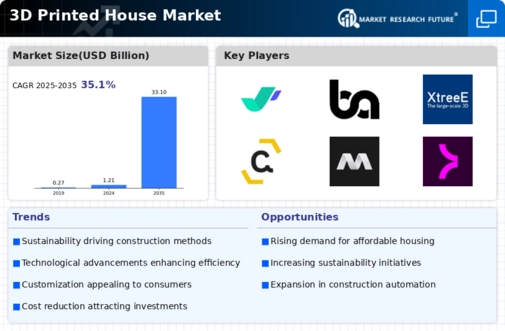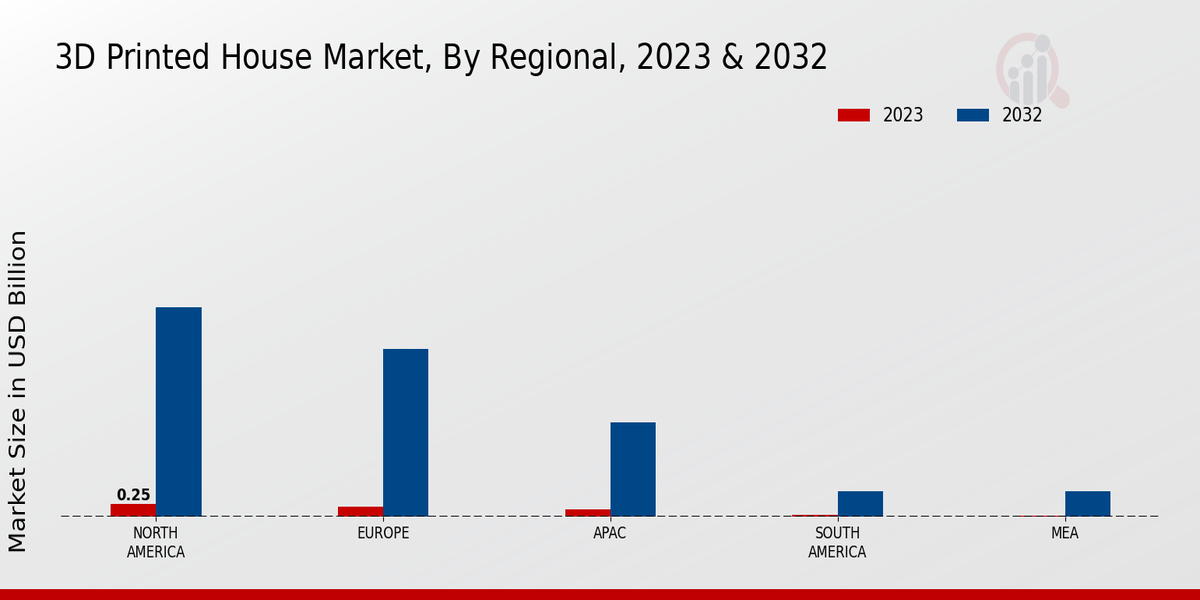Cost Efficiency
Cost efficiency remains a pivotal driver for the Global 3D Printed House Market Industry. Traditional construction methods often entail high labor and material costs, whereas 3D printing can reduce these expenses significantly. By automating the building process, companies can lower labor costs and minimize material waste, leading to overall savings. In 2024, the market is projected to reach 1.21 USD Billion, reflecting the growing recognition of 3D printing as a cost-effective alternative. As the technology matures, it is anticipated that further reductions in construction costs will enhance affordability, making housing more accessible to diverse populations.
Urbanization Trends
Urbanization trends significantly influence the Global 3D Printed House Market Industry. As populations migrate towards urban areas, the demand for affordable housing increases. 3D printing offers a viable solution to address this challenge by enabling rapid construction of homes in densely populated regions. The ability to produce housing quickly and efficiently aligns with the urgent need for urban development. Moreover, the flexibility of 3D printing allows for customization to meet diverse housing needs. This adaptability positions the industry favorably within the broader context of urbanization, suggesting a robust growth trajectory in the coming years.
Market Growth Projections
The Global 3D Printed House Market Industry is poised for remarkable growth, with projections indicating a compound annual growth rate (CAGR) of 35.1% from 2025 to 2035. This growth trajectory is fueled by various factors, including technological advancements, increasing urbanization, and rising demand for sustainable housing solutions. As the market matures, it is expected to attract significant investments, further accelerating its expansion. The anticipated rise from 1.21 USD Billion in 2024 to 33.1 USD Billion by 2035 underscores the transformative potential of 3D printing in the construction sector, positioning it as a key player in the future of housing.
Sustainability Initiatives
The Global 3D Printed House Market Industry is increasingly driven by sustainability initiatives. As environmental concerns rise, the construction sector seeks innovative solutions to reduce waste and carbon footprints. 3D printing technology allows for the use of sustainable materials, such as recycled plastics and bio-based composites, which can significantly lower environmental impact. For instance, companies are developing homes using materials that minimize energy consumption during production. This shift towards eco-friendly construction methods aligns with global sustainability goals, potentially attracting investments and fostering growth in the market.
Technological Advancements
Technological advancements are reshaping the Global 3D Printed House Market Industry. Innovations in printing materials, software, and machinery are enhancing the capabilities of 3D printing in construction. For example, the development of faster and more precise printers allows for complex designs and faster project completion times. These advancements not only improve the quality of printed homes but also expand the potential applications of 3D printing in various architectural styles. As technology continues to evolve, it is likely that the market will experience accelerated growth, with projections indicating a rise to 33.1 USD Billion by 2035.
Government Support and Regulations
Government support and regulations play a crucial role in shaping the Global 3D Printed House Market Industry. Many governments are recognizing the potential of 3D printing to address housing shortages and promote sustainable construction practices. Initiatives such as grants, subsidies, and favorable regulations are being introduced to encourage the adoption of 3D printing technologies in construction. These supportive measures not only facilitate market entry for new players but also stimulate innovation within the industry. As regulatory frameworks evolve to accommodate this emerging technology, the market is likely to witness increased investment and expansion.











